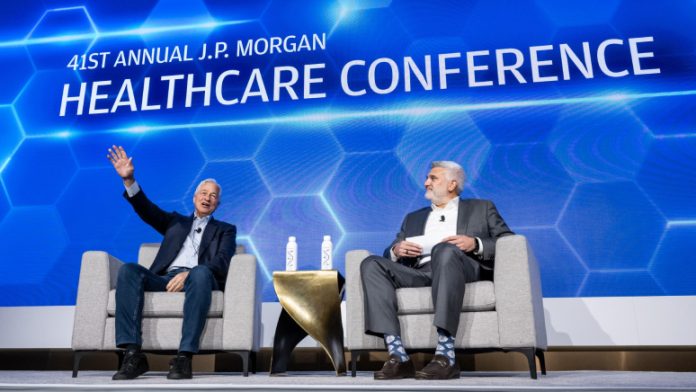Today, the J.P. Morgan Healthcare Conference is one of the annual favorite events in healthcare. In January, San Francisco welcomes thousands of healthcare professionals whose services range from giant pharmaceuticals to the newest kind of biotech company. The following sections trace the importance of the conference to the milestones in the evolution journey, important players, and the Top Trends and Challenges that affect the health universe.
The Evolution of the J.P. Morgan Healthcare Conference
From Humble Beginnings to a Global Powerhouse
Who would have thought, but the J.P. Morgan Healthcare Conference was a small gathering of biotech companies back in the 1980s. It was a pretty simple gathering by a firm called Hamre, Schmid, and Quist. Fast-forward to the early 2000s, after J.P. Morgan acquired the conference, then boom. It became the biggest healthcare investing event around.
The conference is now referred to as the Super Bowl of healthcare investing. It gets healthcare executives investors, researchers, and innovators from all corners of the earth. A place where the future of health care shall be discussed and debated and, importantly, funded.
Also read: Capital One Banking Outage: What You Need to Know Today
Key Highlights from the J.P. Morgan Healthcare Conference 2025
Here are 7 insights on the JP Morgan Healthcare Conference 2025
1. Artificial Intelligence reigns supreme
Artificial intelligence continues to be in the headlines, and its role in drug development is really important. In such a challenging year of 2024 for those in AI and health tech, especially those with no products up to market, the bottom line is this: AI is going to revolutionize the way it approaches drug development. Toward this end, the FDA published draft guidance at the outset of the year signaling how important AI is going to be to drug development going forward. The question is no longer whether AI will be useful but when and how we can effectively leverage it. The world of tech is evermore intertwined with biopharma.
This past week, new collaborations were announced that technology companies like Nvidia have with other healthcare companies in the likes of IQVIA, Illumina, and Mayo Clinic. For another instance, recently the firm Faro Health, a company which falls under one of the technologies with AI-powered signatures, agreed to the deal and became a partnership company of one the other biotechnology partners of the German multinational biotechnology/chemicals and giant company Bayer named Recursion
2. And behind every innovation is some level of investment.
The role of investors in the conference is quite significant; they come in with different objectives and risk appetites. Venture capitalists typically look at early-stage companies, which offer hope of very high growth rates even if they risk going to the bone. On the other hand, institutional investors like pension funds and insurance companies will tend towards more established companies, which are well-proven in investment.
Among them, one of the most impressive is the resurgence of pharmaceutical dealmaking. In 2024, biotech venture deals higher than $100 million hit a count of 106, the first increase of declines from years past. That pattern should continue as more deals are larger because these companies want to bolster pipelines before many drug developers start hitting their patent cliff in the next two years.
The competitive urgency to refill pipelines is intense because patent expirations between now and 2033 translate to $400 billion in lost revenue. It’s the perfect mix of investors that makes a dynamic marketplace for ideas. The conference is more than just a series of presentations; it is a time to network, make partnerships, and cut deals that could change the healthcare future.
3. Navigating Health Policy Questions
It’s rife with uncertainty, at least as that uncertainty pertains to the immediate future of the Inflation Reduction Act under a newly inaugurated Trump administration.
It also seeks to end the so-called “pill penalty,” whereby, under the IRA, the period of exclusivity for small molecule drugs has been reduced to 9 years, whereas biologic drugs will enjoy 13 years. Health policy was not a major campaign focus, so it will be interesting to see what priorities the administration places on this topic. The Emergence of Chinese Innovation
4. The Rise of Chinese Innovation in Biopharma
Last year, one-third of pharma licensing deals had origins in Chinese biotechs, which is an astonishing rise from virtually zero a decade ago. That’s a good sign of increased recognition of high-quality science from China along with the cost advantages these innovations provide. Sure, the U.S. will continue to serve as a world leader in innovative biopharmaceuticals but now, to a greater extent, collaborate with a conducive environment globally allowing good science anywhere in the globe to thrive well. Advancements in Cell and Gene Therapies
Also read: World’s Largest Battery Plant – Moss Landing Power Plant On Fire In Central California
5. Cell and Gene Therapies
Cell and gene therapies are moving along with some great momentum, but no doubt especially exciting developments fall in the treatment area, such as that involving type 1 diabetes. Recently, Sana Biotechnology “announced encouraging data in a first-in-human allogenic cell therapy of type 1 diabetes administered without immunosuppression.”.
Bayer’s subsidiary, BlueRock Therapeutics, announced a plan to move its allogeneic cell therapy for the treatment of Parkinson’s disease to the Phase III stages based on quite solid data from Phase I.
It is starting to create very high hopes for cell and gene therapies as positive human data have begun to arrive, and the examples above are just but a few.
There have been several discussions and recent changes towards value-based care models: patient-care outcomes compared to the volume of service offered. Thus, there is a call for improvement of quality at lower cost in the health care system.
6. Telehealth Extension:
A convention revealed telehealth services have grown further because some of the firms have multiplied the virtual consultation, and even the remote monitoring of patients multiple times.
Trends would remain the same and health care continues to become convenient and easily accessed by each patient.
7. Value-Based Care Models
Most respondents shared their opinion regarding the transition toward value-based care models in which care is more patient-centered rather than volume-driven. Ultimately, the ultimate goal of value-based care models is to make sure that quality is improved and cost is reduced in the healthcare system.
Lessons from the J.P. Morgan Healthcare Conference
Future of Health Care
As we look back to the lessons taken from the J.P. Morgan Healthcare Conference, just crystal clear; that we are now at the cusp of a revolution in healthcare. Science discoveries are unprecedented in the areas of genomics, artificial intelligence, and personal medicine; all this changes the way doctors can diagnose, treat, and prevent diseases.
One of the very pivotal points on where these inventions will slowly gain pickup is from this conference. For all of its imperfections, it drives forward motion from this sector. It will at the subsequent phase be what we need our concerns and qualms to cling to as we pursue our investment for innovation in driving the same idea forward into re-refreshing folks to remind of which they hold some liability of obligation to both an ethical endgame and those of patients themselves.
Conclusion: Why You Should Care
You may never have heard of the J.P. Morgan Healthcare Conference, but it is a pretty powerful event in the healthcare space. What is presented, what deals are done, and which trends are featured will determine treatments and technologies made available to us down the line. Understanding these dynamics as the landscape of healthcare continues to change can be pretty insightful on what the future holds for innovation in healthcare.
So, whether it is a health worker, an investor, or an enthusiast about the future of health, each one of you must be bothered by all the developments taking place at this conference. The contours of the healthcare future are being molded here and futures that all of us stake out our interest for.








